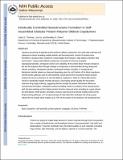| dc.contributor.author | Thomas, Carla S. | |
| dc.contributor.author | Xu, Liza | |
| dc.contributor.author | Olsen, Bradley D. | |
| dc.date.accessioned | 2014-11-07T13:38:31Z | |
| dc.date.available | 2014-11-07T13:38:31Z | |
| dc.date.issued | 2012-08 | |
| dc.date.submitted | 2012-07 | |
| dc.identifier.issn | 1525-7797 | |
| dc.identifier.issn | 1526-4602 | |
| dc.identifier.uri | http://hdl.handle.net/1721.1/91485 | |
| dc.description.abstract | Aqueous processing of globular protein–polymer diblock copolymers into solid-state materials and subsequent solvent annealing enables kinetic and thermodynamic control of nanostructure formation to produce block copolymer morphologies that maintain a high degree of protein fold and function. When model diblock copolymers composed of mCherry-b-poly(N-isopropylacrylamide) are used, orthogonal control over solubility of the protein block through changes in pH and the polymer block through changes in temperature is demonstrated during casting and solvent annealing. Hexagonal cylinders, perforated lamellae, lamellae, or hexagonal and disordered micellar phases are observed, depending on the coil fraction of the block copolymer and the kinetic pathway used for self-assembly. Good solvents for the polymer block produce ordered structures reminiscent of coil–coil diblock copolymers, while an unfavorable solvent results in kinetically trapped micellar structures. Decreasing solvent quality for the protein improves long-range ordering, suggesting that the strength of protein interactions influences nanostructure formation. Subsequent solvent annealing results in evolution of the nanostructures, with the best ordering and the highest protein function observed when annealing in a good solvent for both blocks. While protein secondary structure was found to be almost entirely preserved for all processing pathways, UV–vis spectroscopy of solid-state films indicates that using a good solvent for the protein block enables up to 70% of the protein to be retained in its functional form. | en_US |
| dc.description.sponsorship | United States. Dept. of Energy. Office of Basic Energy Sciences (Award DE-SC0007106) | en_US |
| dc.language.iso | en_US | |
| dc.publisher | American Chemical Society (ACS) | en_US |
| dc.relation.isversionof | http://dx.doi.org/10.1021/bm300763x | en_US |
| dc.rights | Article is made available in accordance with the publisher's policy and may be subject to US copyright law. Please refer to the publisher's site for terms of use. | en_US |
| dc.source | PMC | en_US |
| dc.title | Kinetically Controlled Nanostructure Formation in Self-Assembled Globular Protein–Polymer Diblock Copolymers | en_US |
| dc.type | Article | en_US |
| dc.identifier.citation | Thomas, Carla S., Liza Xu, and Bradley D. Olsen. “Kinetically Controlled Nanostructure Formation in Self-Assembled Globular Protein–Polymer Diblock Copolymers.” Biomacromolecules 13, no. 9 (September 10, 2012): 2781–2792. | en_US |
| dc.contributor.department | Massachusetts Institute of Technology. Department of Chemical Engineering | en_US |
| dc.contributor.mitauthor | Thomas, Carla S. | en_US |
| dc.contributor.mitauthor | Xu, Liza | en_US |
| dc.contributor.mitauthor | Olsen, Bradley D. | en_US |
| dc.relation.journal | Biomacromolecules | en_US |
| dc.eprint.version | Author's final manuscript | en_US |
| dc.type.uri | http://purl.org/eprint/type/JournalArticle | en_US |
| eprint.status | http://purl.org/eprint/status/PeerReviewed | en_US |
| dspace.orderedauthors | Thomas, Carla S.; Xu, Liza; Olsen, Bradley D. | en_US |
| dc.identifier.orcid | https://orcid.org/0000-0002-7272-7140 | |
| mit.license | PUBLISHER_POLICY | en_US |
| mit.metadata.status | Complete | |
